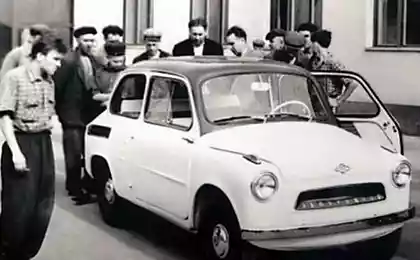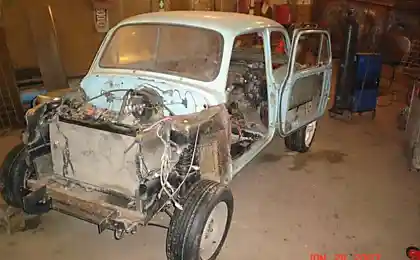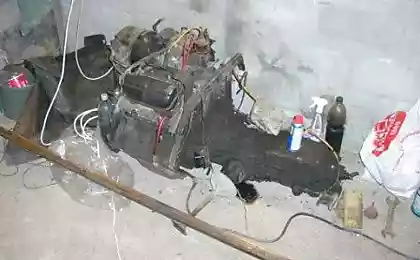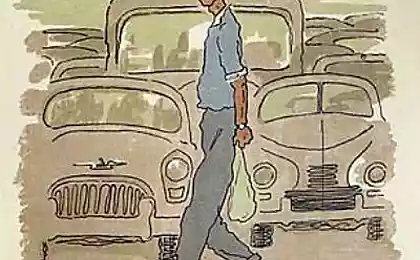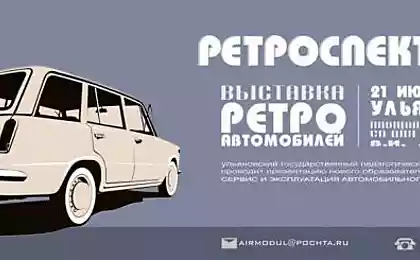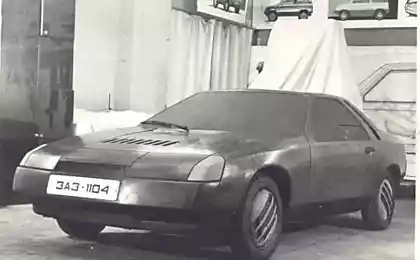393
ZAZ-970 Soviet "microvan"
Today in Japan, one of the most popular types of body is "microvan". In the Soviet Union began to develop such a body in the early 60s.
1960. In Zaporozhye factory "Kommunar" stands on the conveyor new car ZAZ-965, and the designers of the plant led by former gazovtsem Yuri Naumovich Sorochkin already working on new models. Adding to the ministerial plans ZAZ-966, they were not enough and Sorochkin, being not only a talented designer, but also an organizer, persuaded director Sergei Alexandrovich Serikova find internal resources to develop a family of ZAZ-970, which included a truck, a van and a passenger car - now it would be called "mikrovena».
The first sample, called the plant "Grindstone" have a short "hood" and looks a little like ZAZ-965.

"Cabover trailers" appeared in 1962. Extremely functional design ZAZ-970 was developed in the factory bureau architectural design of the car (the concept of "design center" did not yet exist) under the direction of Yuri Viktorovich Daniel and leading designer monocoque was Lev Murashov. Still working on the PCA, he participated in the creation of the "Moskvich-444" - a prototype of ZAZ-965. To ensure the strength of the body with the lifting capacity of 350 kg, had pomudrit. The cross section and the thickness of the side members were selected empirically - no tricky software or even sufficient experience of the Cossacks were not. For the body panels for the first time in the domestic auto industry used steel with thickness 0, 7 mm, its special "dashed off" with the neighbors "Zaporizhstal».
The engine and gearbox on the ZAZ-970 were serial. At the hub of the rear wheels in order to increase the gear ratio set Gear wheel. Motor capacity of 27 liters. from. I clocked loaded machine just to 70-75 km / h, but for distribution of goods around the city, taking into account the velocity of the time, that was enough. The vehicle expended an average of 7, 5 liters of gasoline per 100 kilometers. Motor as standard on the "Zaporozhets" was placed behind, but since the unit was partially under the floor, it was heat-loaded, even less than that of ZAZ-965. But V-shaped engine for the trailer is not suitable. The "Volkswagen" boxer unit all found room under the floor and in the "Zaporozhets" motor acted "hump" in the body. And testers, and "merchants" liked the car, only the "hump" in the back, especially in a van with a single rear door (minibus was at the side), prevented loading and unloading.
Alas, "trade lobby" could not help: the plant barely drew a plan on the approach was "966 minutes", and designers have worked on the ZAZ-969 four-wheel drive vehicle, which was later launched in Lutsk
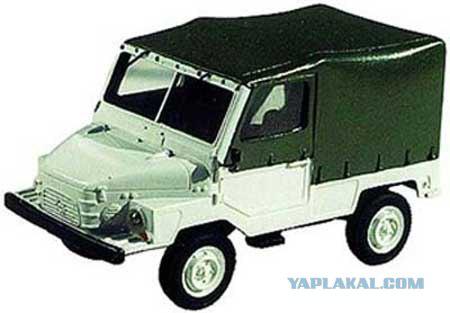
Experimental samples were spelled out in the yard. As usual with these other prototypes gradually removed scarce parts of the body and quickly covered with rust. What happened next, you know ...
Every year, the world of wheels, more compact vans, a few decades, "tasted" and mini-vans. And the "970 th" gradually forgotten. Few of the experience gained was used in the design of ... "Niva". Leo Murashov working already at the WHA and participating in the creation of her body, she applied to spar VAZ 2121 Zaporozhye developments. Well, well at least it was useful ...
So, in fact, the chronology:
One of the first ZAZ-970G to the test. Podshtampovki characteristic on the side, such as in the ZAZ-966, made in order not to inflate the air intake of the cooling system.

ZAZ-971 tilt truck with independent suspension has been redesigned from the first vehicle onboard sample "Grindstone". Body simplified, thereby lifting capacity of 400 kg.

Back in 1965, the factory had hoped that the cargo "Zaporozhets", even if the wagon ZAZ-970B, will be on the conveyor.
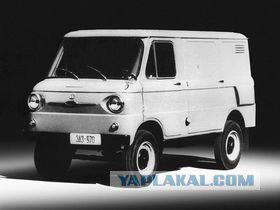
Six-ZAZ-970V 1962 - the ancestor of today's minivans.

Source:
1960. In Zaporozhye factory "Kommunar" stands on the conveyor new car ZAZ-965, and the designers of the plant led by former gazovtsem Yuri Naumovich Sorochkin already working on new models. Adding to the ministerial plans ZAZ-966, they were not enough and Sorochkin, being not only a talented designer, but also an organizer, persuaded director Sergei Alexandrovich Serikova find internal resources to develop a family of ZAZ-970, which included a truck, a van and a passenger car - now it would be called "mikrovena».
The first sample, called the plant "Grindstone" have a short "hood" and looks a little like ZAZ-965.

"Cabover trailers" appeared in 1962. Extremely functional design ZAZ-970 was developed in the factory bureau architectural design of the car (the concept of "design center" did not yet exist) under the direction of Yuri Viktorovich Daniel and leading designer monocoque was Lev Murashov. Still working on the PCA, he participated in the creation of the "Moskvich-444" - a prototype of ZAZ-965. To ensure the strength of the body with the lifting capacity of 350 kg, had pomudrit. The cross section and the thickness of the side members were selected empirically - no tricky software or even sufficient experience of the Cossacks were not. For the body panels for the first time in the domestic auto industry used steel with thickness 0, 7 mm, its special "dashed off" with the neighbors "Zaporizhstal».
The engine and gearbox on the ZAZ-970 were serial. At the hub of the rear wheels in order to increase the gear ratio set Gear wheel. Motor capacity of 27 liters. from. I clocked loaded machine just to 70-75 km / h, but for distribution of goods around the city, taking into account the velocity of the time, that was enough. The vehicle expended an average of 7, 5 liters of gasoline per 100 kilometers. Motor as standard on the "Zaporozhets" was placed behind, but since the unit was partially under the floor, it was heat-loaded, even less than that of ZAZ-965. But V-shaped engine for the trailer is not suitable. The "Volkswagen" boxer unit all found room under the floor and in the "Zaporozhets" motor acted "hump" in the body. And testers, and "merchants" liked the car, only the "hump" in the back, especially in a van with a single rear door (minibus was at the side), prevented loading and unloading.
Alas, "trade lobby" could not help: the plant barely drew a plan on the approach was "966 minutes", and designers have worked on the ZAZ-969 four-wheel drive vehicle, which was later launched in Lutsk

Experimental samples were spelled out in the yard. As usual with these other prototypes gradually removed scarce parts of the body and quickly covered with rust. What happened next, you know ...
Every year, the world of wheels, more compact vans, a few decades, "tasted" and mini-vans. And the "970 th" gradually forgotten. Few of the experience gained was used in the design of ... "Niva". Leo Murashov working already at the WHA and participating in the creation of her body, she applied to spar VAZ 2121 Zaporozhye developments. Well, well at least it was useful ...
So, in fact, the chronology:
One of the first ZAZ-970G to the test. Podshtampovki characteristic on the side, such as in the ZAZ-966, made in order not to inflate the air intake of the cooling system.

ZAZ-971 tilt truck with independent suspension has been redesigned from the first vehicle onboard sample "Grindstone". Body simplified, thereby lifting capacity of 400 kg.

Back in 1965, the factory had hoped that the cargo "Zaporozhets", even if the wagon ZAZ-970B, will be on the conveyor.

Six-ZAZ-970V 1962 - the ancestor of today's minivans.

Source:

